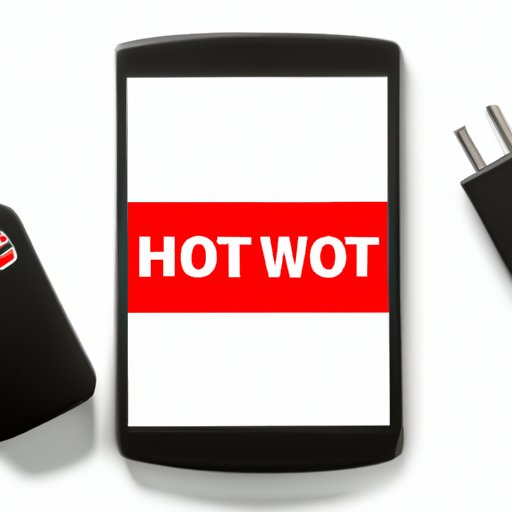
Introduction
Do you need to connect your laptop or tablet to the internet but don’t have a Wi-Fi network available? One option you can try is using your iPhone as a hotspot. A hotspot allows you to share your phone’s internet connection with other devices nearby via Wi-Fi, Bluetooth, or USB. In this article, we will guide you in detail on how to turn on hotspot on iPhone and provide you with tips and troubleshooting solutions to optimize your hotspot connection.
Step-by-Step Guide on How to Turn On and Use Hotspot on Your iPhone
To turn on hotspot on your iPhone, you need to have cellular data enabled on your device. Follow these steps to turn on hotspot:
- Open the Settings app on your iPhone.
- Select “Personal Hotspot.”
- Toggle the switch on next to “Personal Hotspot.”
Once you’ve turned on hotspot, you can now connect other devices to your iPhone’s network. Here’s how:
- On the device you want to connect, go to Settings and select Wi-Fi.
- Look for your iPhone’s network name in the list of available networks.
- Select your iPhone’s network and enter the password if prompted.
It’s important to note that when using your iPhone as a hotspot, you are using your cellular data. To avoid exceeding your data plan, you can monitor your data usage by going to Settings > Cellular Data. You can also turn off the hotspot feature when you’re not using it by going to Settings > Personal Hotspot and toggling the switch off.
Tips for Improving Your iPhone’s Hotspot Signal Strength
When using your iPhone as a hotspot, there are several factors that can affect your signal strength, such as the distance between your device and the connected devices and the number of connected devices. To optimize your hotspot connection, consider the following tips:
- Find the most centralized location for your iPhone to ensure that the signal reaches all connected devices.
- Reduce the number of connected devices to improve bandwidth. If possible, limit the number of devices connecting to your hotspot to only essential ones.
- Use Bluetooth tethering instead of Wi-Fi if you’re connecting a device that’s nearby. Bluetooth has a shorter range, so it’s less likely to get overloaded and works well for short distances.
Using Your iPhone’s Hotspot for Remote Work: A Guide
Using your iPhone’s hotspot for remote work can be a useful tool for staying connected while working remotely. Not only does it offer you increased mobility, but it also adds an extra layer of security when working with sensitive information. To optimize your hotspot connection when working remotely, consider the following tips:
- Use a Virtual Private Network (VPN) to encrypt your connection and protect your data from potential intruders.
- Connect your devices to a high-speed Wi-Fi network to ensure that your connection remains stable.
- Close any unnecessary applications when using your iPhone’s hotspot to minimize data usage and improve your connection speed.
Troubleshooting Common Hotspot Issues and Solutions on Your iPhone
Like any technology, hotspot connections may not always work as intended. Here are some common issues users may experience when trying to turn on their iPhone’s hotspot feature and the solutions for addressing them:
- Connection errors: If you’re unable to connect to your iPhone’s hotspot, try resetting your network settings or restarting your iPhone and the device you’re trying to connect.
- Device compatibility issues: Some devices may not be compatible with your iPhone’s hotspot. Check your device’s user manual to see if it supports tethering with an iPhone
- Data usage: Exceeding your data plan when using your hotspot can be costly. To avoid overage fees, set up data usage alerts or monitor your data usage regularly.
The Pros and Cons of Using Your iPhone as a Hotspot
Before you decide to use your iPhone as a hotspot, it’s essential to weigh the advantages and disadvantages. Here are some factors to consider:
- Advantages: Using your iPhone as a hotspot allows you to connect to the internet where Wi-Fi networks are unavailable. It also adds an extra layer of security when working remotely.
- Disadvantages: Using your iPhone as a hotspot may drain your battery faster and eat up your data plan quickly, leading to overages charges if you’ve exceeded your data limit.
Conclusion
In conclusion, turning on hotspot on your iPhone can be a handy tool for sharing your cellular internet connection with other devices. It’s easy to set up, but it’s essential to monitor your data usage to avoid exceeding your plan’s limits. By following the tips and troubleshooting solutions provided in this guide, you can optimize your hotspot connection and use it effectively for remote work or personal use.





